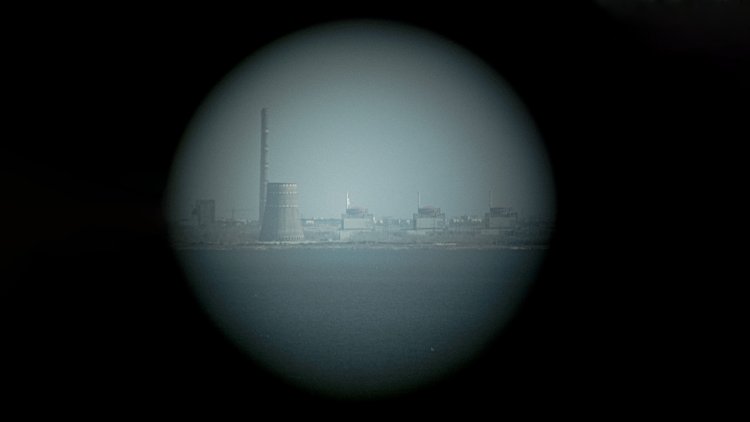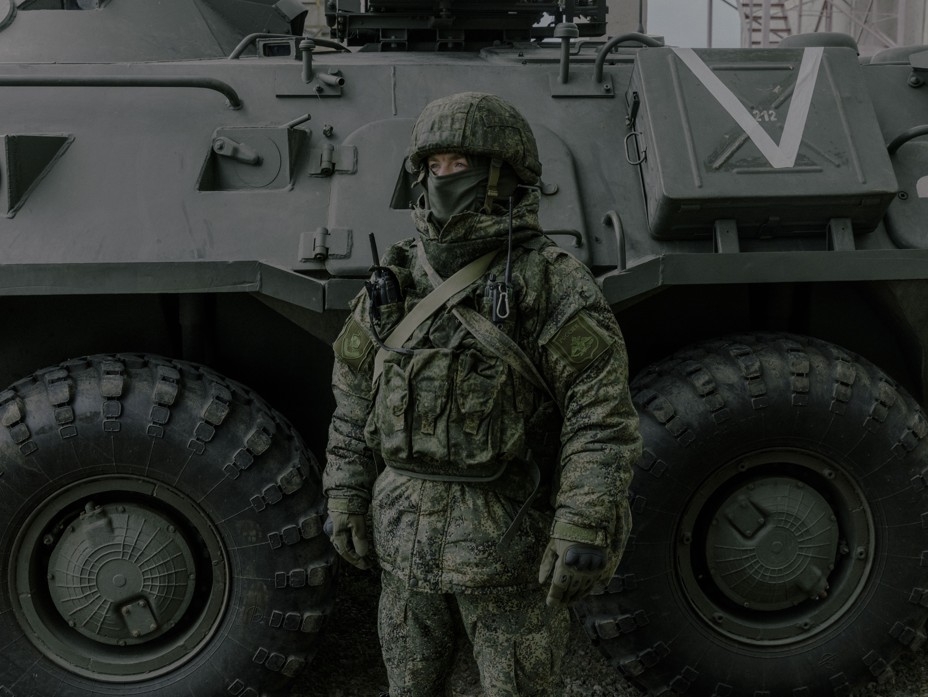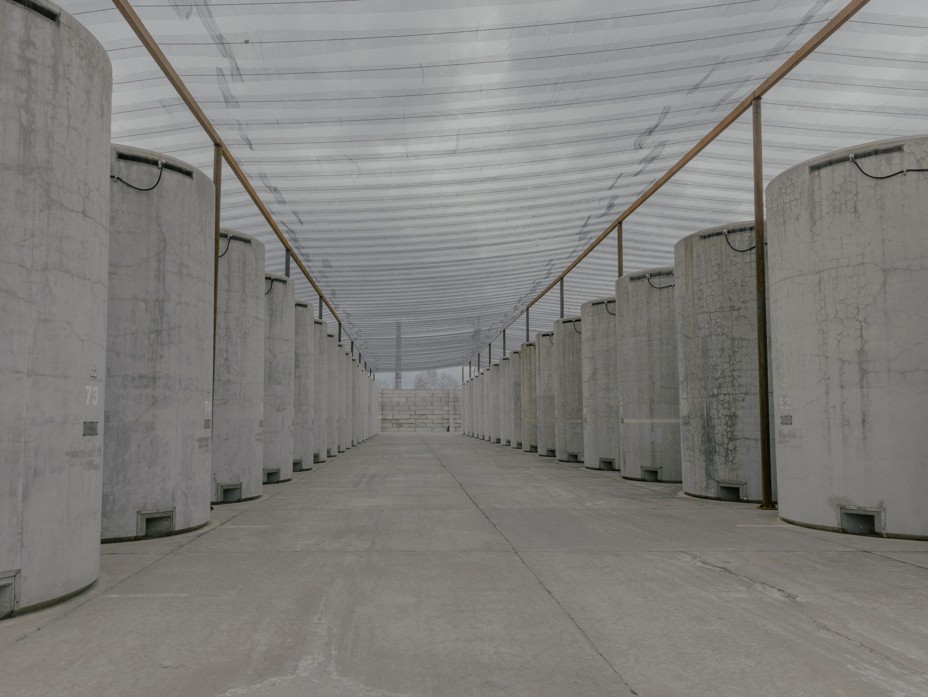A Looming Disaster at the Zaporizhzhia Nuclear Power Plant
At the facility, occupied by Russia for the past two years, employees describe a regime of torture and abuse—and a growing threat of disaster.

This article is based on interviews and research by the Reckoning Project, a multinational group of journalists and lawyers collecting evidence of war crimes in Ukraine.
The Zaporizhzhia Nuclear Power Plant, in the city of Enerhodar, in eastern Ukraine, is Europe’s largest nuclear facility. For decades, it has supplied electricity to millions of households, not just in Ukraine, but in Hungary, Poland, Belarus, Moldova, Slovakia, and Romania as well. Until two years ago, more than 50,000 people lived in Enerhodar. Eleven thousand worked at the plant, and nearly everyone in Enerhodar had some sort of connection to it.
When Russia began its invasion, in 2022, it moved aggressively into the Zaporizhzhia region, raising fears about the safety of the plant. On February 27, 2022, just three days into the offensive, a Russian convoy advanced toward Enerhodar. For the next three days, as employees of the Zaporizhzhia plant, known as the ZNPP, worked to keep it running, residents took to the streets in an attempt to stop Russian military vehicles and troops from entering. The mayor tried to negotiate directly with the Russians.
But residents’ hopes that the Russians wouldn’t dare attack the nuclear facility were misplaced. On March 3, there were reports that troops had started to shoot at the crowd. That night, one part of the Russian column entered the city center while the other advanced to the nuclear facility. The Ukrainian National Guard engaged Russian forces outside the plant, but soon shelling from Russian tanks started a fire, which continued to burn as Russian troops blocked firefighters from entering the plant’s perimeter. A ZNPP worker said residents scrambled to find potassium-iodide pills in case the fighting unleashed a wave of radiation.
Nuclear plants must be continuously staffed to avoid the risk of a meltdown. Another ZNPP worker recalled staying on the job for 30 straight hours, until Russian soldiers finally allowed the next shift to enter the facility. By the morning of March 4, the plant was entirely in Russian hands. About a week later, employees of Rosatom, the Russian state nuclear corporation, arrived at the ZNPP to take operational control. On March 12, the Russian forces occupying the ZNPP reportedly declared that it was “now a Rosatom station.” They had, in effect, stolen the largest power plant on the continent.
Though the fighting at the plant had stopped, the danger was not over. The ZNPP is a Soviet-built facility, but it had been reconfigured and modernized after the 2011 disaster at Fukushima, in Japan. As a result, Rosatom could not fully substitute its own technicians and staff. All of the plant’s six reactors have now been shut down, and the plant is not actively producing electricity, but the reactors still need to be cooled around the clock to prevent them from releasing radioactive material, a process that requires specialized technicians, divers, and other staff, all with training in the specific parameters of the ZNPP.
Even in peaceful times, work at a nuclear-power plant is a high-stress proposition: Small mistakes can lead to disastrous results. Before the occupation, the ZNPP maintained rules, endorsed by the International Atomic Energy Agency, or IAEA, governing who was allowed to enter and work at the plant, including a licensing process for operators that can take almost a decade, and screenings by psychologists. But now the plant is severely understaffed: Whereas 11,000 employees once ran the facility, only about 3,000 people were working there as of last month. These employees are pulling longer shifts with fewer days off.
Ukrainians who stayed on to work at the plant say they did so under duress. Employees report that Russian occupiers coerced them into adopting Russian citizenship and signing contracts with Rosatom. According to a recent IAEA report, the plant has announced that workers still officially employed by Energoatom, Ukraine’s state nuclear company, are barred from the site. The workforce “now consists of former Energoatom employees who have adopted Russian citizenship and signed employment contracts with the Russian operating entity, as well as staff who have been sent to the ZNPP from the Russian Federation.”
On top of that, current and former employees of the ZNPP, some of whom escaped past enemy lines, have said that Russia brutalized the plant’s dwindling workforce, resorting to torture to keep workers in line. They also report that Russia is violating international law by using the plant as a military staging ground, further increasing the risks to the facility. This claim has been supported by satellite evidence.
From the start of the war, Energoatom has objected to the occupation of the ZNPP, and raised alarms about the dangers the plant faces. Recently, the IAEA has also issued warnings about the degrading state of the ZNPP and the continued potential for a meltdown. In February, it issued a bulletin warning that the plant’s last backup external power line had been disrupted, creating a “precarious” situation. Today, the IAEA’s director general, Rafael Mariano Grossi, met with President Vladimir Putin and Alexei Likhachev, the head of Rosatom, in a closed-door session to discuss his concerns about the plant. But the agency has thus far been ineffectual in compelling Russia to cooperate, and its authority does not extend to claims of human-rights abuses away from the plant, even when they involve employees.
The result is a crisis unprecedented in the history of nuclear power. A disaster at the facility would be most immediately harmful to the people living near it. But the ZNPP is located in the watershed of the Dnipro River, which flows through southern Ukraine and into the Black Sea. If a meltdown occurs at the ZNPP and affects the waterways, experts indicate that all of southern Ukraine might be at risk for contamination. 

In their stories of working at the ZNPP after the Russian occupation began, several sources describe incidents of detentions, interrogations, and torture. Kostiantyn Chebaievskyi worked at the ZNPP until August 2022, when he says he was arrested at the end of his shift and imprisoned by Russians. Chebaievskyi says he was accused of communicating with Ukrainian authorities and that interrogators beat him and tried to force him to make a false confession. Other people employed at the ZNPP at the time say that cells intended to hold four to six people were used to detain up to 20 prisoners without any food, save what their relatives were able to bring on visits.
Chebaievskyi says that one form of torture involved what his captors called “a phone call to Lenin.” According to Chebaievskyi, the men would clip one cable to his earlobe and another to his finger, and then interrogate him while they turned the crank on a modified field telephone that would deliver a shock. “Everything goes dark,” he said. “All that you see is white lighting.” Chebaievskyi said that the interrogators repeated the procedure over and over, demanding to know his supposed contact in Ukraine. He also reported that some prisoners were forced to give interviews for Russian television crews, reciting prewritten scripts that were complimentary toward Russia. Chebaievskyi was released after 18 days, and then managed to escape from the city.
Other ZNPP employees corroborate allegations of abuse and torture. Volodymyr Zhaivoronok is a 50-year-old former equipment operator who says he was imprisoned for 53 days, many of them in the same cell where Chebaievskyi ended up. Zhaivoronok says Russian personnel beat the prisoners, targeting their backs, necks, and shoulders. “One is bringing you into the room, and another six people come there,” Zhaivoronok told me and my colleagues at the Reckoning Project. “They come in with batons, pistols.” He recalled that the torture room was covered in blood, and prisoners were forced to clean it. Zhaivoronok said that during one of the sessions, his torturers shot him in the side with a rubber bullet.
Zhaivoronok said he witnessed the death of Andrii Honcharuk, who worked as a diver in the plant’s water tanks. According to Zhaivoronok, in July 2022, Honcharuk was interrogated and beaten, after which he fainted and his breathing stopped. “We managed to scream loud enough to make them call an ambulance,” Zhaivoronok said. The guards allowed medics to take Honcharuk to the hospital, but he did not survive.
The Russians changed their interrogation methods after Honcharuk’s death, Zhaivoronok said, and beatings became less violent. Still, one employee I talked with last year, Kira, said that abuses continued. On the day we spoke, in July 2023, I could still see bruises on her face and arms. She had just fled 75 miles through Russian territory. Her escape had taken days.
Kira is in her early 30s, and worked at the ZNPP for the past five years. (She asked that we withhold her real name and information about her job at the ZNPP because she fears for her safety.) After the Russian occupation, she said, she and other Ukrainian ZNPP personnel continued running the facility under the watch of armed Russian soldiers.
On July 20, Kira said, eight to 10 armed men suddenly broke into her house. They wore bulletproof vests over civilian clothes, and covered their faces. She assumes that the men were with the FSB, Russia’s security service. According to Kira, the men blindfolded her with a rag, but she managed to work out that they were taking her to a local police station. She said they beat her and asked her about the location of her partner, who also worked at the ZNPP. She replied that she didn’t know where he was. “Oh, the hell you don’t know,” she heard the men say.
Kira said she was beaten and tortured, and that the men attached electrical cables to her ears: “‘I don’t know anything, I don’t know anything!’ I screamed.” Kira said that the rag covering her eyes slipped, and she saw that the torturers were beating her with a rolled-up ream of paper. She recalled that they beat her over the head, which resulted in a broken blood vessel in one eye, and the bruises that I saw. She said that the men also shoved a gun in her mouth.
“They beat me powerfully, on the floor; they knocked me to the floor,” she said. “One beat me with some kind of cord, some kind of white cable.” She said another man stepped on her face. “When I was on the floor, I was told: ‘Now we’ll call the Chechens; they like girls like you.’” Kira said the men dialed a number and she heard a voice talking on the other end. “Nobody came and raped me, but I was imagining how I could commit suicide by hanging myself up on my trousers.” 
In addition to these alleged human-rights abuses—and the stresses they placed on besieged employees—Russia and Rosatom have behaved in other ways that jeopardize the safety of the entire region. In previous Reckoning Project reporting in The Atlantic, on Russia’s disastrous occupation of the inactive Chernobyl nuclear plant, eyewitnesses insisted that Russian forces brought dangerous weapons, equipment, and vehicles to the plant and operated the equipment in close proximity to nuclear materials. The Russian forces appeared to be using the facility to stash military equipment, apparently hoping that the Ukrainian forces would avoid a direct attack on the plant for fear of spreading radiation contamination—the Russians were using the Chernobyl plant as a “nuclear shield.”
ZNPP employees claimed in 2022 that their plant also became a shield. They reported that they heard what they believed to be Russian mortar shells launched from within or near ZNPP territory, and also saw Russian military equipment in crucial locations of the plant, including turbine halls near reactors. This equipment included armored personnel carriers and trucks, tanks, anti-aircraft systems, and rocket launchers. These sources also stated that Russian soldiers—possibly hundreds of them—have been deployed to the plant, and have complete access to spaces designated for evacuation and sheltering. These claims were supported in a September 2023 report, commissioned by Greenpeace, that used satellite imagery to identify signs of military activity in the vicinity of the plant. An accident involving military equipment and ordnance could damage the systems needed to cool the reactors, and could lead to a leak of radioactive material.
The operation of Zaporizhzhia, like that of all nuclear-power plants, is subject to international law, and to regular inspections by the IAEA, a treaty organization that reports to the United Nations. Since the beginning of the occupation, the IAEA and its director general, Grossi, have made several visits to Ukraine and to the ZNPP in particular, and have offered ongoing assistance to the plant’s administrators. In May, Grossi told the UN Security Council that the situation at the ZNPP “continues to be extremely fragile and dangerous,” and noted that the plant did not have enough staff to maintain safety measures, even with the reactors shut down. Grossi added that there had been seven occasions since the occupation began when the plant lost off-site power and had to rely on diesel generators, “the last line of defence against a nuclear accident.” (The plant has since suffered another external power loss.) In that address, Grossi asked that Russia abide by certain principles in its operation of the plant, including refraining from using it for military weapon storage.
By its own admission, the IAEA, which declined comment for this story through a spokesperson, has struggled to change Russia’s behavior. In September, Grossi reported that ensuring Russia was following accepted international principles had been impossible. IAEA inspectors were not allowed into crucial areas in the ZNPP to check them for explosives, and they heard explosions and other military activity near the vicinity of the plant. Other inspections, including some conducted last week, have found mines placed around the perimeter of the plant in violation of the IAEA’s outlined principles. Last month, Grossi made his fourth trip to the ZNPP, this time citing concerns that staffing levels remained low. Grossi has alluded to “unprecedented psychological pressure” on the existing staff—but allegations of torture outside the plant itself do not fall within the IAEA’s mandate.
The IAEA’s inability to avert the risks at the ZNPP exposes the weaknesses of international law in times of war. There’s little the agency can do to pressure Russia into improving conditions at the plant. (Full details about Grossi’s conversation today with Putin are not currently known, but Grossi did warn Russian authorities against trying to restart the plant. Russian state media described the talks as “tense.”) According to Serhii Plokhy, the Ukrainian American historian and author of Atoms and Ashes: A Global History of Nuclear Disaster, this situation illuminates the necessity of reforming international treaties to make attacks on nuclear power a global red line. “Never in history have nuclear facilities been occupied by armed forces,” Plokhy told me. He added that it is now clear that there is no leverage to force combatants to respect nuclear safety, which could encourage recklessness in future conflicts.
Today, according to Grossi, the ZNPP is the single most vulnerable nuclear facility in the world. Petro Kotin, the head of Energoatom, says that even though all six reactors are shut down, the nuclear fuel within them continues to emit radiation, and will soon reach the end of its six-year recommended life span. Failing to remove the fuel, Kotin wrote last month, “may lead to the destruction of the integrity of the fuel cells and, as a result, to a radiation accident.” According to Kotin, the only way to know if the fuel is still safe would be to conduct a special analysis—one that few employees remaining at the plant are qualified to do.
That concern is just one of many. As the IAEA has noted recently, after several recent power outages, all backup external power lines to the plant are now inoperable, meaning the on-site diesel generators are the only option in the case of an emergency. The Kakhovka reservoir, which was used as the main water source for cooling the ZNPP’s reactors, also provided water for homes, farms, and industry in the area. But in June 2023, the Kakhovka dam, which maintains the reservoir, exploded. The exact cause is still unclear, but the dam was under the control of Russian soldiers at the time. The explosion led to flooding in numerous Ukrainian towns. But it also meant that, in order to cool its reactors, the power plant now has to rely on on-site spray ponds, for which ZNPP employees dug several groundwater wells, a solution that Grossi says is unsustainable. And as fighting continues in the region, the risk of a military accident remains an urgent concern.
The situation at the ZNPP is precarious, but not yet hopeless. Edwin Lyman, the director of nuclear-power safety at the U.S.-based nonprofit Union of Concerned Scientists, describes the current condition as an “uneasy status quo.” Lyman says that the biggest threat to the ZNPP now “is either deliberate sabotage, or the plant being caught in an all-out battle,” which could cause substantial damage to multiple reactors and safety systems. Lyman is skeptical of the possibility of a Chernobyl-style meltdown. “If there was just an accident, internally or as a result of a single explosion, you would likely see a slower and probably smaller release that wouldn’t disperse as far,” Lyman told The Atlantic.
Because all of the reactors at the plant are shut down, there is an “additional safety margin,” Lyman said: ZNPP employees would likely have days, rather than hours, to address an accident. But if they struggle to respond adequately, “then the progression of the accident is not going to be much different from what you saw at Fukushima.” In that worst-case outcome, Lyman and the IAEA agree, the area immediately surrounding the plant could become significantly contaminated. Radiation could enter local waterways and affect people in communities across the south of Ukraine for years to come.
According to Kotin, theorizing about the most likely nuclear disasters is beside the point. He says that as long as the ZNPP is being used as a military base, there will always be a likelihood of some kind of incident, one that would be devastating to the people working and living in Enerhodar, people who already bear the scars of war and occupation.
Additional reporting was provided by Angelina Kariakina, Inna Zolotukhina, and Hanna Sylayeva.
What's Your Reaction?




















